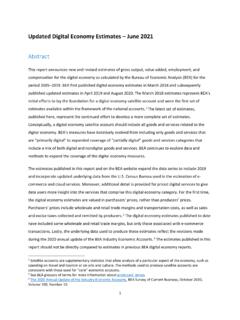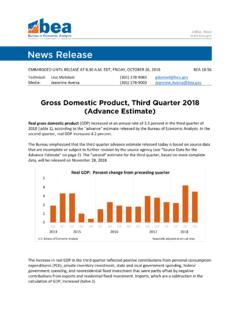Transcription of Updated and Revised Estimates of the U.S. Space Economy ...
1 1 Updated and Revised Estimates of the Space Economy , 2012 2019by Tina Highfill, Annabel Jouard, and Connor FranksOn December 17, 2020, the Bureau of Economic Analysis (BEA) released preliminary Estimates of 2012 2018 gross output, value added, employment, and compensation for the Space Economy for the first time. This article describes Updated and Revised Space Economy statistics for 2012 2019 that build on the prelim-inary Estimates by incorporating new source data and improved methods. These Updated statistics now in-clude improved measures of depreciation and inventories, along with new statistics that show the price-ad-justed Estimates (also referred to as chained-dollar or real Estimates ) of gross output and gross domestic product (GDP).
2 Specifically, the Updated Space Economy statistics provide Estimates of the Space Economy s contribution to overall current-dollar and chained-dollar gross output and GDP by industry, as well as private employment and compensation statistics. The Updated and Revised statistics show that, in 2019, the Space Economy accounted for $ billion of real gross output, $ billion of real GDP (translating to percent of GDP), $ billion of private industry compensation, and 354,000 private sector jobs.
3 See the appendix to this report or BEA s Space Economy website for the detailed data tables. The Space Economy statistics were built using BEA s comprehensive supply-use tables, which provide insight into the internal workings of the Economy and detail the contribution of specific industries and commodities to GDP. The supply-use data detail the flows of goods and services purchased by each industry, the incomes earned from production in each industry, and the distribution of sales for each commodity.
4 The goal of the Space Economy statistics is to highlight the Space -related production and spending that is already present in the supply-use tables. In practice, these data represent a rearrangement of the current supply-use data to isolate Space Economy spending and production. A detailed description of the basic methodology, in-cluding background information on BEA concepts and general national accounting methods, is available in the December 2020 Survey of Current Business. This report begins with a short summary of the major findings from the Updated statistics, focusing on the chained-dollar Estimates of gross output by industry.
5 We then describe the revisions made to the 2012 2018 preliminary Estimates arising from Updated source data and methodological improvements. We follow with a discussion of trends in the Space Economy to help provide context to the Estimates and conclude with a summary of possible next steps for the 20222 Real Gross OutputThe gross output of an industry is the market value of the goods and services produced by an industry. Real or constant-dollar Estimates hold prices constant such that growth rates for real Estimates reflect changes in quantities produced, removing the impact of Real gross output growth for the Space Economy was strong and positive for 2012 2015, averaging percent.
6 Growth then slowed from 2015 2016, down to percent, and since 2016 growth has been negative. Average annual growth over the full 2012 2019 period was percent, slightly slower than the overall growth rate of percent for those The industries with the largest contributions to real gross output growth between 2012 and 2015 were manufacturing, whole-sale trade, and information. For 2015 2019, manufacturing remained a large contributor to growth, while wholesale trade experienced slower growth over those years, eventually contracting in 2019.
7 Information experienced declines for the entire 2015 2019 period, dragging down the overall Space Economy due to its rel-ative importance. Chart 1 shows real gross output for the top four industries over the 2012 2019 period. In 2016, manufac-turing overtook information as the largest industry in the Space Economy in terms of real gross output due to the decline in the information sector over the second half of the period, coupled with strong overall growth in the manufacturing sector. Chart 1. Space Economy Real Gross Output for Top 4 Industries1.
8 Chained-dollar Estimates are calculated by taking the current-dollar level of a series in the reference period and multiplying it by the change in a chained-type quantity index number for the series since the reference period. Chained-dollar Estimates correctly show growth rates for a series, but are not additive in periods other than the reference Table Real Gross Output by Industry, published December 22, highlights include: Manufacturing experienced strong annual growth between 2012 and 2019, percent on average. This growth was mostly driven by the computer and electronic products industry, which includes satellite and Global Positioning System (GPS) and positioning, navigation, and timing (PNT) equipment manufacturing, where annual growth rates averaged percent for 2012 2019.
9 Most of that growth is concentrated in 2012 2018, as Estimates slowed to percent in 2019. Wholesale trade had the largest negative contribution to growth in 2018 2019, declining by percent. Wholesale trade had strong positive growth in the first half of the time series, averaging percent between 2012 and 2016, but started to slow beginning in 2017. The wholesale trade sector consists of the margins or markups charged by wholesale distributors for Space -related items, such as GPS transceivers and antennae. Wholesale distributors typically sell items to other businesses for use as intermediate inputs into other goods.
10 Information declined by percent for 2018 2019, following the same trend of negative growth that began in 2016. Wired telecommunications carriers, which includes direct-to-home (DTH) satellite television, is by far the largest industry in this sector and also one of the larger industries in the overall Space Economy . Annual declines in the wired telecommunications carriers industry of 5 percent or more per year starting in 2016 drove down growth in the information sector and overall. Government was the largest contributor to growth for 2018 2019, growing by 9 percent, driven almost entirely by federal spending (which includes many Space -related government agencies, though chiefly NASA and Department of Defense3).



![[FR Doc. 85-22841 Filed 9-24-85; 8:45 am]](/cache/preview/9/e/3/b/4/0/3/e/thumb-9e3b403ea4e7f3535028925dd1410980.jpg)





